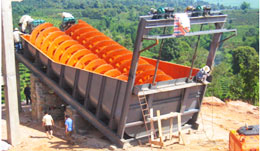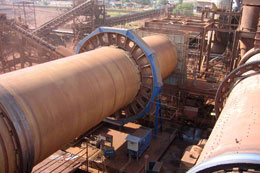-
Sand Making Crusher
- PCL-Vertical Shaft Impact Crusher
- SBM Hydraulic VSI Crusher
- VSI5X Series Impact Crusher
Feldspar quarrying equipments
Feldspar minerals
Feldspars are among the most important mineral groups on the earth. Although the group of feldspar has 20 minerals, only nine of them are well known. These minerals make up the largest percentage of minerals in nature.
Feldspar quarrying process

Crushing and pulverizing is a simple process. If the feldspar is slightly altered it is occasionally calcined to remove the combined water, but ordinarily it is broken with sledges or with a jaw crusher to about 2-inch sizes and feed into a "MXB" mill. This mill is a kind of new high-tech milling machine to meet the requirements of coarse powder processing customers. The crushed material is screen and the coarse material returned to the MXB mill, while the fine material is fed to ball mills. The latter are steelbarrel tumbler mills 6-07 feet long and of about the same diameter. They are lined with hard wood or silica blocks and the charged with French flint pebbles 2-3 inches in diameter. The revolving of the mill causes the pebbles to roll or slide, thus pulverizing the feldspar.
The pulverized feldspar is rarely screened, but the degree of fineness is determined by testing small samples of the material, and the length of the grinding period is depended on to give the desired pulverization. If the pegmatite carries mica the pulverized material should be screened through a fine sieve to remove any unpulverized material.
- Limestone Crusher
- Barite Crusher
- Granite Crusher
- Kaolinite Crusher
- Calcite Crushing
- Tombarthite Crusher Mill
- Bentonite Grinding Plant
- Basalt Ore Crusher
- Lignite Crusher Mill
- Silica Ore Crusher
- Tin Ore Mine
- Lead and Zinc Ore Crusher
- Ochre Crusher Mill
- Garnet Crusher
- Mica Crusher
- Asbestos Crusher
- Manganese Ore Crusher
- Talc Crusher Mill
- Feldspar Crusher
- Iron Ores Crusher
- Dolomite Crusher
- Quartz Crusher
- Gypsum Crusher
- Calcium Carbonate Grinding
- Feldspar process equipments
- Feldspar quarry machinery
- Feldspar mining process
- Feldspar Crusher
- Feldspar grinding equipments
- Feldspar beneficiation process
- About Us
- |
- Service
- |
- News & Events
- |
- Contact Us
- |
- Resources
- |
- Showroom
Aggregate Crusher
Artificial Sand Making
Ballast Crushing Machine
Basalt Stone Crusher
Barite Mine Process
Beneficiation Plant
Bentonite Crusher
Bentonite Milling
Calcium Carbonate Crusher
Calcium Carbonate Grinding
Cement Grinding
Concrete Crusher
Coal Crusher
Copper Crusher
Cement Mill
Chrome Mining Process
Copper ore Beneficiation
Coal Processing
Coal Pulvarizer
Feldspar Crushing
Feldspar Grinding
Flotation Machine
Gold Crusher
Gold Mine Equipment
Gold Processing Machinery
Granite Crusher
Granite Crushing Machine
Granite Quarry Equipment
Gypsum Crusher
Gypsum Mining
Gypsum Powder Production
Iron Ore Beneficiation
Iron Ore Crusher
Kaolin Processing Plant
Limestone Crusher
Silica Sand Crusher
Iron Ore Mining Equipment
Cement Production Line
Talc Production Line
Quartz Crushing Machine
Limestone Mining Process
Manganese Benificietion
























